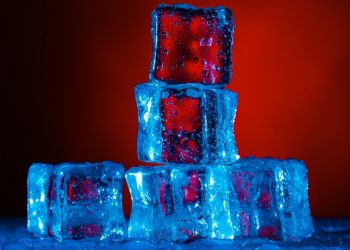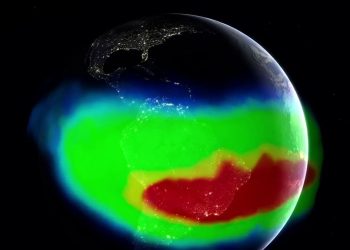UHT differentiation of continental crust. The diagrams show the processes involved in refining immature continental crust into stable crust and cratons. Credit: Natural geosciences (2025). DOI: 10.1038/s41561-025-01820-2
For billions of years, Earth’s continents have remained remarkably stable, providing the foundation for mountains, ecosystems and civilizations. But the secret of their stability has mystified scientists for more than a century. Now, a new study by researchers at Penn State and Columbia University provides the clearest evidence yet of how landforms became and remained so stable — and the key ingredient is heat.
In an article published today in the journal Natural geosciencesResearchers demonstrated that the formation of stable continental crust, which lasts billions of years, required temperatures above 900 degrees Celsius in the planet’s lower continental crust. Such high temperatures, they said, were essential for the redistribution of radioactive elements like uranium and thorium. Elements generate heat as they decay, so as they move from the bottom to the top of the crust, they carry heat with them and allow the deeper crust to cool and strengthen.
According to the researchers, the implications of this discovery extend beyond geology, and pave the way for modern applications such as the exploration of critical minerals, essential for modern technologies such as smartphones, electric vehicles and renewable energy systems, and the search for habitable planets.
The processes that stabilized the Earth’s crust also mobilized rare earth elements – lithium, tin and tungsten – providing new clues about where to find them. The same processes that promoted the stability of continental crust are likely to occur on other Earth-like planets, the researchers said, giving planetary scientists new signs to search for life on other worlds.
“Stable continents are a prerequisite for habitability, but for them to achieve that stability, they need to cool,” said Andrew Smye, associate professor of geosciences at Penn State and lead author of the paper. “To cool, they have to move all those heat-producing elements – uranium, thorium and potassium – to the surface, because if those elements stay deep down, they create heat and melt the crust.”
Continental crust as we know it appeared on Earth about 3 billion years ago, he said. Before this time, the composition of the crust was markedly different from that of modern crust, which is rich in silicon. Scientists have long believed that the melting of pre-existing crust is an important ingredient in the recipe that produces the stable continental plates that support life. However, prior to this study, it was not recognized that the crust must reach extreme temperatures to become stable.
“Basically, we’ve found a new recipe for creating continents: They need to get much hotter than previously thought, about 200 degrees hotter,” Smye said.
Consider forging steel, he says.
“The metal is heated until it becomes just soft enough that it can be shaped mechanically by blows with a hammer,” Smye explained. “This process of deforming metal under extreme temperatures realigns the metal structure and removes impurities, both of which strengthen the metal, resulting in the toughness of the material that defines forged steel. In the same way, tectonic forces applied during the creation of mountain belts forge continents. We have shown that this forging of the crust requires a furnace capable of withstanding temperatures ultra-high.”
To draw their conclusions, the team sampled rocks from the Alps of Europe and the southwestern United States, and examined data published in the scientific literature. They analyzed whole-rock chemical data from hundreds of samples of metasedimentary and metaigneous rocks (the types of rocks that make up much of the lower crust), then ranked the samples based on their peak metamorphic temperatures, when rocks undergo physical and chemical changes while remaining mostly solid.

Composition of the continental crust. The graph shows the values of major and trace element concentrations for the upper (red) and lower (blue) continental crust estimates, normalized to the overall continental crust. The shaded gray arrow highlights the enrichment and depletion of the upper and lower crust in Th and U, respectively. Credit: Natural geosciences (2025). DOI: 10.1038/s41561-025-01820-2
Researchers distinguished between high temperature (HT) and ultra high temperature (UHT) conditions. Smye and his co-author, Peter Kelemen, a professor of earth and environmental sciences at Columbia University, noticed a striking consistency in the composition of rocks that melted at temperatures above 900°C: They had significantly lower concentrations of uranium and thorium than rocks that melted at lower temperatures.
“It’s rare to see a consistent signal in rocks from so many different places,” he said. “It’s one of those eureka moments where you think ‘nature is trying to tell us something here.'”
He explained that melting of most types of rock occurs when the temperature exceeds 650°C, which is a little more than six times the temperature of boiling water. In general, the deeper you go into the crust, the temperature increases by about 20°C for every kilometer of depth. Since the base of most stable continental plates is about 30 to 40 kilometers thick, temperatures of 900 °C are not typical and have forced a rethinking of the temperature structure.
Smye explained that early in Earth’s history, the amount of heat produced by the radioactive elements that make up the crust (uranium, thorium and potassium) was about double what it is today.
“There was more heat available in the system,” he said. “Today we wouldn’t expect to produce as much stable crust because there is less heat available to forge it.”
He added that understanding how these very high temperature reactions can mobilize elements from the Earth’s crust has broader implications for understanding the distribution and concentration of critical minerals, a group of highly sought-after metals that have proven difficult to mine and locate. If scientists could understand the reactions that first redistributed valuable elements, they could theoretically better locate new deposits of the material today.
“If you destabilize minerals that contain uranium, thorium and potassium, you also release a lot of rare earth elements,” he said.
More information:
Andrew J. Smye et al, Ultra-hot origins of stable continents, Natural geosciences (2025). DOI: 10.1038/s41561-025-01820-2
Provided by Pennsylvania State University
Quote: Earth’s continents stabilized due to oven-like heat, study finds (October 13, 2025) retrieved October 14, 2025 from https://phys.org/news/2025-10-earth-continents-stabilized-due-furnace.html
This document is subject to copyright. Except for fair use for private study or research purposes, no part may be reproduced without written permission. The content is provided for informational purposes only.









